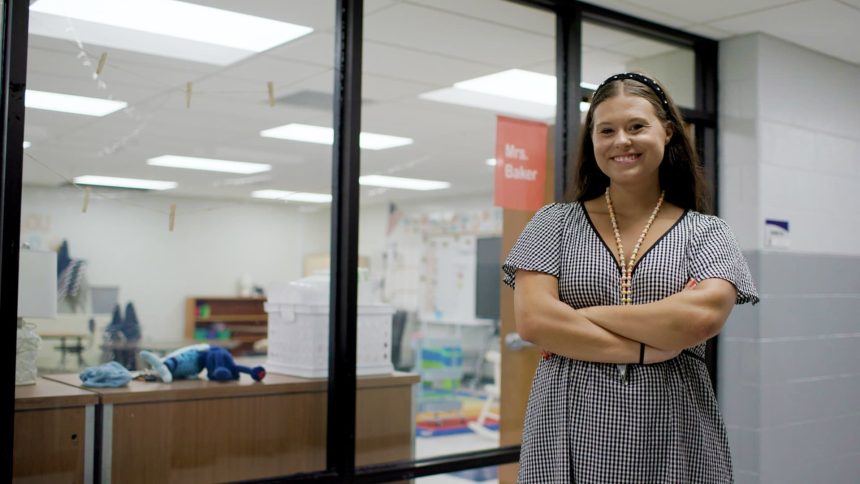The Struggles of Teaching
This article is part of CNBC Make It’s Millennial Money series, showcasing how individuals across the globe manage their finances. Maddie Baker, a 27-year-old first-grade teacher from Rockingham, Virginia, remembers her mother’s cautionary words when she expressed interest in becoming an educator: “Don’t do it.” Her mother, a teacher who raised Maddie and her siblings alone, recognized the financial challenges that come with the profession, especially evident during the holiday season when Baker’s mom faced a six-week paycheck gap due to school breaks.
“I watched her struggle a lot … But I’m the type of person that if my mom [tells] me not to do it, naturally, I’m going to do it,” Baker shared. Despite her mother’s warnings, Baker felt a calling to teach.
A Reliable Income With a Side Venture
Baker is set to enter her sixth year of teaching with an expected salary of around $58,000 for the upcoming school year. To supplement her income and achieve financial goals, such as building an emergency fund and saving for a home, she has turned to social media content creation. This year, she anticipates earning an additional $5,000, raising her total projected income to approximately $63,000 before taxes.
The Teaching Hustle
For Baker, teaching is an ongoing hustle. Before fully committing to content creation in early 2024, she sought various side jobs to earn extra cash. She spent a summer tutoring students, and took on additional roles at her school that include managing its Facebook page and mentoring new teachers.
“The majority of people I know are doing something extra to try to make money,” Baker noted. National data from the National Education Association reveals that 40% of primary and secondary school teachers hold multiple jobs, with 37% struggling to make a living wage. For instance, Baker’s sister, a fellow educator and nurse, works a few shifts each week in healthcare.
Managing Finances Wisely
In May, Baker reported a take-home income of about $5,000 before taxes, combining her teaching and side job earnings. She exercises caution with her spending, opting to do her own nails instead of visiting a salon and meal prepping each week to maximize her grocery budget. She recalls the unsustainable habit of buying daily coffees, stating, “Starbucks is a special occasion for me,” now preferring to brew coffee at home.
Baker splits living expenses evenly with her husband, a truck driver earning $53,000 annually. They do not share a joint bank account but manage their bills, including pet costs for their dachshund-chihuahua mix, Junie, named after a children’s book character. “It’s a little bit nontraditional, but it works really well for us and the current stage [of life] we’re in right now,” she remarked. Paying all their bills solely on her teacher’s salary, Baker believes, would be a daunting challenge.
Detailed Breakdown of Expenses
Baker’s May Spending
- Savings and investments: $883 toward savings and retirement funds
- Housing and utilities: $875 for her half of their one-bedroom apartment
- Camera purchase: $790 for a new camera funded by social media earnings
- Discretionary spending: $614 on a friend’s wedding, household items, clothing, and a gift for her mother
- Transportation: $579 for car-related expenses
- Food: $426 on groceries and dining out
- Health: $303 covering medical bills, therapy, health insurance, and medication
- Teaching supplies: $92
- Subscriptions and memberships: $78 on streaming services and a gym membership
- Phone bill: $55
Additionally, Baker is managing $32,000 in student loan debt, which she began paying off in June through an income-driven repayment plan as the federal payment pause was set to end.
The Impact of Her Side Hustle
Baker strategically allocates her income, directing her teacher paycheck into her checking account for daily expenses while her social media earnings, which can fluctuate between $0 to $2,000 monthly, go into savings. This approach is intentional; as she explained, “I wanted to be really specific about not increasing my income just to spend more money, but increasing my income to be able to achieve some goals I have.”
With her content creation income, she purchased a Canon G7 X camera that she had long desired. Looking ahead, she aims to prioritize savings for a future home with her husband, while also using extra earnings to purchase teaching supplies and small gifts for her students. In her previous summer, Baker spent nearly $1,000 to enhance her classroom’s functionality. Despite receiving a supply stipend from her school, she acknowledged that many items essential for her classroom’s success are purchased from her own pocket. According to a National Education Association survey, 95% of U.S. teachers report spending their own money to address classroom needs. “All of the organizational supplies I have in my classroom were things I needed to buy myself,” Baker emphasized. “In order for my classroom to function and for my students to be successful, I need those things.”
Baker’s dedication to her profession is driven not only by financial necessity but also by her desire to make a meaningful impact in her students’ lives.






